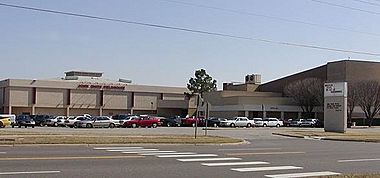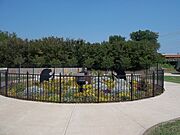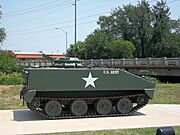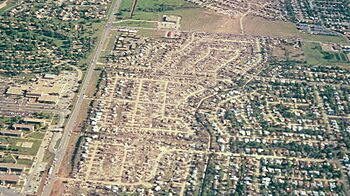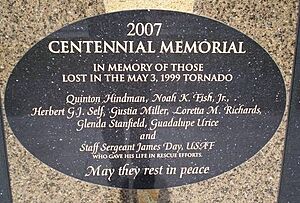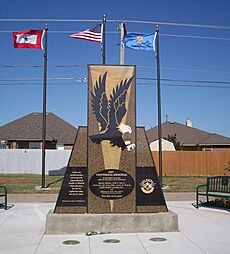Del City, Oklahoma facts for kids
Quick facts for kids
Del City, Oklahoma
|
|||
|---|---|---|---|
|
City
|
|||
|
|||
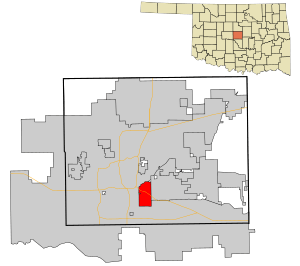
Location in Oklahoma County and the state of Oklahoma.
|
|||
| Country | United States | ||
| State | Oklahoma | ||
| County | Oklahoma | ||
| Settled | 1940s | ||
| Incorporated | October 9, 1948 | ||
| Founded by | George I. Epperly | ||
| Named for | Delaphene Campbell | ||
| Government | |||
| • Type | Council–manager | ||
| Area | |||
| • Total | 7.52 sq mi (19.47 km2) | ||
| • Land | 7.52 sq mi (19.47 km2) | ||
| • Water | 0.00 sq mi (0.00 km2) | ||
| Elevation | 1,211 ft (369 m) | ||
| Population
(2020)
|
|||
| • Total | 21,822 | ||
| • Density | 2,902.63/sq mi (1,120.68/km2) | ||
| Time zone | UTC−6 (Central (CST)) | ||
| • Summer (DST) | UTC−5 (CDT) | ||
| ZIP codes |
73115, 73117, 73135
|
||
| Area code(s) | 405, 572 | ||
| FIPS code | 40-19900 | ||
| GNIS feature ID | 2410313 | ||
| Website | City of Del City | ||
Del City is a city in Oklahoma County, Oklahoma, in the United States. It's part of the larger Oklahoma City metropolitan area. In 2020, about 21,822 people lived here.
Del City is located close to two big highways, Interstate 40 and Interstate 35. These highways connect the city to Oklahoma City. Del City is next to southeast Oklahoma City, Midwest City, and Tinker Air Force Base.
The city was started by George Epperly. People living there voted to make it an official city in 1948. Del City is named after Epperly's oldest daughter, Delaphene Campbell. Since it became a city, Del City has grown bigger three times by adding nearby areas.
A large part of Del City was badly damaged by a huge tornado on May 3, 1999. This tornado was part of a big storm system that hit the Oklahoma City area.
Contents
History of Del City
Del City began as a "bedroom community," meaning people lived there but often worked in nearby cities. It's about 3 miles (5 km) east of Oklahoma City and 1 mile (1.6 km) west of Midwest City. Today, Del City is about 7.5 square miles (19.47 km2) in size.
The city's boundaries are defined by major streets: NE 10th Street to the north, Sooner Road to the east, SE 44th Street to the south, and Bryant Avenue to the west. Its location near the crossing of Interstate 35 and Interstate 40 makes it an important spot.
In 1946, a developer named George Epperly bought a large wheat field. He planned to build fifty houses there. By 1948, there were 582 homes in the area. Most of these were built by George Epperly. Even though some people didn't want it, the residents voted to make Epperly Heights an official city on October 9, 1948. In 1959, Del City set up its own city government with a council and a city manager. The city was named after Epperly's daughter, Delaphene Campbell.
The city grew by adding areas like Carter Park in 1954 and Midway Village in 1963. Del City also gained some undeveloped land near Tinker Air Force Base. In 1964, Del City reached its current size. The city also helped fund the Little River Reservoir Project, which created Lake Thunderbird.
The Del City Historical Society was started in 1975. They found out that their town was on the path of the Arbuckle Trail. This was a cattle trail from Texas to Kansas in the 1870s.
Most people in Del City have always commuted (traveled) to work in other places. However, some businesses have been around for a long time. Don's Alley Restaurant was a popular spot for many years. Midwest Trophy Manufacturing (now called MTM Recognition) started in Del City in 1971. It's the city's largest employer, with about 400 people working there.
Del City is represented in the Oklahoma Legislature by local representatives and senators. At the national level, it's represented by a U.S. Representative and two U.S. Senators. The city has also had its own newspapers and a government TV channel called KDEL.
Geography and Climate
Del City covers about 7.5 square miles (19.47 km2) of land. It is located in the center of Oklahoma, in a region called Frontier Country.
The city is in the Sandstone Hills region. This area has hills that are about 250 to 400 feet (76 to 122 m) high. It also has two types of oak trees: blackjack oak and post oak.
Del City is in an area known as the Cross Timbers. This is a mix of grassy prairies and patches of forest. It's a transition zone between the wetter eastern Oklahoma and the drier western plains. This area can have big changes in weather, from very dry to very wet. Because of these weather patterns, Del City is in Tornado Alley. This means it's one of the most tornado-prone areas in the United States.
Eagle Lake is located in the northern part of Del City. It's the only large body of water in the city. The lake is home to different types of fish, like bass, catfish, and crappie.
Weather in Del City
| Climate data for Del City, Oklahoma | |||||||||||||
|---|---|---|---|---|---|---|---|---|---|---|---|---|---|
| Month | Jan | Feb | Mar | Apr | May | Jun | Jul | Aug | Sep | Oct | Nov | Dec | Year |
| Mean daily maximum °F (°C) | 46 (8) |
51 (11) |
59 (15) |
69 (21) |
77 (25) |
86 (30) |
91 (33) |
91 (33) |
82 (28) |
73 (23) |
59 (15) |
50 (10) |
70 (21) |
| Mean daily minimum °F (°C) | 28 (−2) |
32 (0) |
37 (3) |
50 (10) |
59 (15) |
68 (20) |
71 (22) |
69 (21) |
62 (17) |
51 (11) |
39 (4) |
32 (0) |
50 (10) |
| Average precipitation inches (mm) | 0.9 (23) |
1.3 (33) |
1.9 (48) |
3.1 (79) |
5.7 (140) |
3.7 (94) |
3.2 (81) |
2.4 (61) |
3.8 (97) |
2.5 (64) |
1.6 (41) |
1.4 (36) |
30.5 (770) |
| Source: The Weather Channel Weatherbase.com | |||||||||||||
People of Del City
| Historical population | |||
|---|---|---|---|
| Census | Pop. | %± | |
| 1950 | 2,504 | — | |
| 1960 | 12,934 | 416.5% | |
| 1970 | 27,133 | 109.8% | |
| 1980 | 28,523 | 5.1% | |
| 1990 | 23,928 | −16.1% | |
| 2000 | 22,128 | −7.5% | |
| 2010 | 21,332 | −3.6% | |
| 2020 | 21,822 | 2.3% | |
| Sources: | |||
In 2010, there were 21,332 people living in Del City. The population was highest in 1980, with 28,523 people.
About 26% of the population in 2010 was under 18 years old. The average age was 35 years.
Economy and Jobs
Del City is next to Tinker Air Force Base, which is the biggest employer in Oklahoma. Other important employers nearby include Rose State College and AllianceHealth Midwest. Many people also work for companies connected to the base or in the larger Oklahoma City metropolitan area.
Education in Del City
Most of Del City is served by the Mid-Del School District. This district has one high school (Del City High School), one middle school (Del City Middle School), and three elementary schools (Del City Elementary School, Epperly Heights Elementary School, and Townsend Elementary School) located within Del City.
A small part of Del City is in the Oklahoma City Public Schools district. Students in this area attend Bodine Elementary School, Webster Middle School, and Capitol Hill High School.
Del City also has three private schools: Destiny Christian School, Cristo Rey, and Christian Heritage Academy. Rose State Community College is also located close to Del City.
Arts and Culture
Fun Events
Every May, Del City hosts an annual Armed Forces Day Parade. This parade is put on by the city and the Shriners, a group known for their community work.
Museums and Interesting Places
You can learn about history at the Oklahoma County & Western Museum and the Del City Preservation & Historical Society. The Oklahoma Country Western Music Hall of Fame often has live bluegrass and country music shows.
War Memorial
There is a special war memorial across from the Del City Community Center. It honors 21 service members from Del City who died while serving in the U.S. Military during World War II, the Vietnam War, and the Iraq War. The memorial was dedicated in November 2010. It includes an armored personnel carrier (a type of military vehicle) and a Fallen Soldier Battle Cross. There is also a time capsule at the memorial.
Parks and Recreation
For outdoor fun, Del City has the Del City Ball Park and three trails for biking and walking. Eagle Lake is also a great spot for recreation. The Eagle Harbor Aquatic Center water park is located behind the community center.
Religion
Del City's largest church is St. Paul the Apostle Catholic Church. It started in 1956 as the St. Francis Xavier Church. The church grew, and in 1967, its name was changed to St. Paul the Apostle Catholic Church.
The 1999 Tornado
A large part of Del City was severely damaged by the Bridge Creek–Moore F5 tornado on May 3, 1999. This tornado was one of the strongest ever recorded. It first touched down southwest of Amber, Oklahoma. When it entered Del City, it was about half a mile wide. The tornado moved through the city, causing a lot of destruction. Hail and strong winds also affected the surrounding areas. President Bill Clinton visited Del City a few days later to see the damage.
This tornado was the last one in the United States to be classified as an F5 tornado under the old Fujita scale system. Even so, most of the damaged areas were rebuilt within a few years. Today, you can still see where the tornado passed by looking for new homes, missing large trees, and a break in the evergreen trees along Sooner Road.
A memorial stands along a walking and bike path on Sooner Road. It honors the seven people who lost their lives in Del City during the May 3 tornado. United States Air Force Staff Sergeant James Day is also listed on the memorial. He died in an accident while patrolling an area of Tinker Air Force Base that was damaged by the tornado.
This tornado was the deadliest and most destructive of the many tornadoes that hit Oklahoma City that day. A documentary called Ultimate Tornado on the National Geographic Channel talks about this powerful storm. The tornado caused a total of 36 deaths across the Oklahoma City area.
Notable People from Del City
- Nick Blackburn – A Major League Baseball player who pitched for the Minnesota Twins.
- Bob Kalsu – A football player for the Buffalo Bills who attended Del City High School. He was killed during the Vietnam War.
- J. T. Realmuto – A current Major League Baseball player for the Philadelphia Phillies.
- Josh Scobey – A former NFL football player.
- John Smith – A famous wrestler who won two Olympic gold medals and four World Championships.
- Pat Smith – John Smith's younger brother, who was the first wrestler to win four NCAA Division I National titles.
See also
 In Spanish: Del City (Oklahoma) para niños
In Spanish: Del City (Oklahoma) para niños





